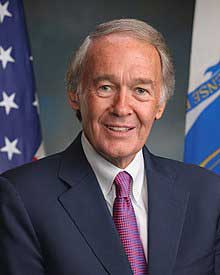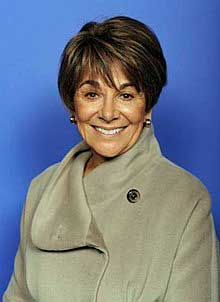


Emily Taylor – our first full time advocate – has a plan…
The ME/CFS community has been making valiant stabs at advocacy for quite a while. The stabbing, though, is over. That kind of ad hoc effort disappeared when the Solve ME/CFS Initiative (SMCI) hired the first full-time advocate for ME/CFS ever – Emily Taylor. Angst and righteous anger was always only going to get us so far. What we really needed was a full-time professional, and we now have one.
Emily, in concert with ME Action and others, is committed to move us forward on the biggest stage of all – the federal level. With tens of millions of potential dollars for ME/CFS at the federal level, the stakes are huge but the difference now is that we have a plan.
I first spoke with Emily in 2017 about that plan. Last summer, we spoke again, and now on the eve of the biggest Advocacy Day ever, I got an update.
Building The Infrastructure for Success
Emily said the Solve ME/CFS Initiative has been investing in building the infrastructure for research and advocacy success. Advocacy, particularly on the Congressional level, is a long-term strategic effort with potentially enormous payoff. Congressional advocacy requires both careful planning and nimble opportunistic leaps to reap the best benefit.
One of those potential payoffs is the mighty NIH, which, with its $40 billion budget, is easily the biggest medical research funder in the world. We complain a lot about the NIH – and with good reason – but it’s worth knowing that even treating ME/CFS as an afterthought, as something hardly worthy of study, the NIH is still, with its $13 million or so spending on ME/CFS annually, easily the biggest ME/CFS research funder in the world. Think what it could do if it actually tried.
We have no choice but to crack the nut that is the NIH, and doing so is one of Emily Taylor’s biggest goals.
How difficult that task is was demonstrated by Vicky Whittemore, who, even with the public support of NIH director Francis Collins and NINDS director Walter Koroshetz, failed to get even half of the Trans-NIH Working Group to provide even minimal support for the ME/CFS research centers. It took her over a year to get funding for three small centers, and in the end, Francis Collins’ office had to throw some money in. Even then, the Working Group only coughed up about as much money as it did when the little Office of Research on Women’s Health (ORWH) produced an RFA ten years earlier.
I asked Emily why we can’t just ask the NIH to give us $20 million for an RFA. She replied, if only the NIH worked like that! Without a piece of legislation passed by Congress that specifically says the NIH must spend $X million on ME/CFS, she said, the NIH’s approach to ME/CFS is hamstrung by their existing structures.
The NIH system is not set up to handle the issues that diseases like ME/CFS come with. Neglected patients simply aren’t part of the NIH’s equation. The NIH is structured to respond to supply and demand, which in this case means researcher interest. Patients’ needs or disease burden is not part of the NIH equation. No part of the grant application process allows reviewers to increase scores for underfunded or misunderstood diseases.
That’s why it’s been so easy for so long for the NIH to fail with us. It’s set up, unfortunately, to respond precisely where we are weakest – researcher interest.
Plus, the fact that we’re not in an Institute means no Institute can make an executive decision to spend x number of dollars more on us.
Compelling Argument
Emily said we’re not the only disease the NIH is failing at. Half the diseases are getting more than their disease burden suggests they should, and half the diseases are below the curve – getting less than their disease burden suggests they should. We are an outlier, though. We’re getting much, much less than our burden of illness suggests we should.
Emily said, the burden of illness argument is a highly compelling, logical argument that we can make – just not with the NIH. It does, however, appeal greatly to lawmakers who seek to resolve injustices. The Advocacy Day coming up shortly is designed to give us visibility and enroll lawmakers in taking specific actions to improve the situation for ME/CFS.
Disease burden helps us make a strong case, but you still have to present a path forward and cultivate the political will to walk that path, Emily said. The squeaky wheel gets the grease – we have to make noise to move forward.
Just how powerful Congress can be is illustrated by Duchenne’s disease – a heartbreakingly difficult but very rare disease which affects about 17 male births per 100,000. It receives about $30 million in funding from the NIH, in part because some people associated with it are in positions of power. (One person was a provost of a University and one was a prominent Capital Hill lobbyist.)
On the downside, we’re in a situation where we’re almost guaranteed – at the moment – to not expect any significant changes in funding from the NIH. We’re not in an Institute and we’re being funded by a Working Group which clearly has little interest in funding us.
On the plus side, we have strong allies inside the NIH who are helping us, and we’re steadily building support in Congress. Our big goal – a piece of legislation requiring funding for ME/CFS – is a long-term process, but Emily said we are taking the necessary steps to achieve it.
Getting Past First Base
The Congressional game is a long and slow one, but it is working. Last year, 102 people attended 122 Congressional meetings. Amy Carlson, from the TV show Blue Bloods, joined them, and Congressman Gus Bilirakis lent his support to the effort.
In the two years she’s been working with Congress, Emily said, our concerted efforts there have led to a change in tone. There are still the skeptics, but more and more she’s finding staffers who are familiar with our issue and allow her to get to the meat of the issue – what we want their boss (i.e. member of Congress) to do.
She compares the process to dating. The first date is educational – you sit down with a staffer and show how your issue is a good match for his/her boss’s support. On the second date, you get a bit deeper into the issue. On the third date, you begin to talk about partnering, and specifically what we’re going to do together.
Our long-term goal is a bill which provides a Congressionally authorized increase in funding for ME/CFS. Getting a bill to the floor of the House and Senate is not something that can be done overnight. It requires building up support step by step. At each step of the way, the SMCI, ME Action and other advocates are in contact with supportive staffers and House and Senate members – getting their advice on how best to achieve our ultimate goal.
The pathway for the big bill is being prepared in several ways. Educating members of Congress – particularly those on important Committee panels – so that they are ready to sign off on the bill when it comes is a general, long-term goal.
More specific steps include having the Senate pass resolutions on MECFS, getting hearings in the House, and having Congress sign onto guidance documents we can use to support our case for better agency action. For instance, guidance to AHRQ that gets ME/CFS designated as a medically underserved population opens up certain grant opportunities.
The Senate Resolution
Emily said she looks at short-term, middle-term, and long-term goals. The short and middle-term goals should ideally lend support to the long-term goal. For instance, our middle-term goal on the Senate side is a U.S. Senate resolution which states that the Senate recognizes that ME/CFS is a disease of major unmet needs and supports our goals of increased funding. This is a 2-3 year project.
Resolutions are non-binding law, but they go through the same process (committee, floor) and constitute statements or opinions of the U.S. Senate. Because they are voted on by Congress, they provide an excellent mechanism for educating Congressmen and women, building support for our cause, and getting them on the record. When we come back with a bill at some point, we can point to their vote and say, you supported us then and we expect your support now.
Last year, the SMCI worked with ME Action and Massachusetts M.E. to introduce – with 10 co-sponsors – SR 508, an ME/CFS resolution which was modeled on a similar resolution on multiple sclerosis which passed a couple of years ago. (The last Senate resolution on ME/CFS was in 1993.)
SR 508 was filed by one of our champions, Senator Ed Markey of Massachusetts on May 1st, 2018. The 10 co-sponsors included some very prominent Senators, including, on the Democrat side: Diane Feinstein, Elizabeth Warren, Sherrod Brown, and Corey Booker, and on the Republican side, Susan Collins. Two of the co-signers (Booker, Warren) have announced that they’ll be running for President in 2020.
We didn’t expect that Resolution would pass last year, and it didn’t, but it laid the groundwork for its reintroduction in 2019 – utilizing a different process this year. This year, they hope to introduce it and get it passed in the congressional session containing May 12 (International ME/CFS Awareness day). (Two congressional sessions occur a year.)
A Hearing at the Big House
ME/CFS Advocacy day last May included a request for a hearing at the House Committee on Energy and Commerce, not on research, but on a new topic for us – access and availability to clinical care. A letter to the House Committee capturing the crisis in clinical care was put together using the work of Mary Dimmock, an SMCI Board member. Emily said she wanted to talk about the fact that we have only a handful of ME/CFS experts to treat a million sick people in this country.
The Hearing – another stepping stone to actual legislation – is probably, again, a 2-3 year project. Hearings are a first step towards legislation. After they identify key issues, stakeholders sit down with agency officials, estimate funding, and write a bill. A year or two after a hearing, legislation is introduced.
Representative Bilirakis sits on the Energy and Commerce Subcommittee on Health – an important position for us. Given his connection to ALS (he was involved in the 21st Century Cures Act), he’s very clued in to chronic illness issues.
(In 2018, three bipartisan requests were made to hold a hearing on the topic, and there was additional interest in hosting an official staff briefing to educate this powerful committee.)
After ME/CFS Advocacy Day in 2018, the (then) chair of the subcommittee, Representative Burgress, agreed that he would incorporate ME/CFS into a planned hearing on Chronic Illnesses.
Then the shift in power in the House of Representatives after the recent election brought us some very good news: the Committee is now chaired by long-time ME/CFS champion Congresswoman Ana Eshoo, and our chances for getting a hearing and starting the process for an actual bill that would increase funding for ME/CFS are looking stronger.
Our Champions
Talking about champions, I asked Emily who some of our champions are and how they came to be champions for our cause. Zoe Lofgren and Anna Eshoo are two House members who represent neighboring districts, have traditionally been aligned with each other, and have provided us with valuable support.
Eshoo has a friend who has ME/CFS, and Zoe Lofgren became enthusiastic after being contacted numerous times by advocates. Plus, the house staffer who used to represent Zoe Lofgren was enthusiastically behind the issue. Put all these pieces together – a personal connection, lots of communication from advocates, an enthusiastic staff member – and you get two real champions for ME/CFS.
The two co-authored a 55-person House of Representatives letter stating that they supported ME/CFS. That letter helped Vicky Whittemore, when she was having trouble raising money for the NIH Research Centers, get over the hump and get the three NIH ME/CFS centers funded.
The House Flip
Some biomedical issues are bipartisan – both parties, for instance, support biomedical research and have resisted the Trump administration’s efforts to cut NIH funding to the bone. Both also support improved access to care. Both Republicans and Democrats shot down the Trump administration’s proposed elimination of AHRQ, which supports access to rural health care.
Where the parties diverge is among issues like preventative health care, chronic care, support for people with pre-existing conditions, and the Affordable Care Act. Emily avoids these issues in order not to burn any bridges. Instead, she’s focused on bipartisan issues like research funding and access – which happen to be our most pressing issues anyway.
Another dividing line concerns the NIH. While Republicans (other than the President) strongly support NIH funding, they tend to take a hands-off approach to influencing what the NIH is doing. Democrats, on the other hand, are more comfortable exerting influence when they feel an injustice is present.
We have some Republican champions, but thus far the Democrats have mostly owned the ME/CFS issue. After advocacy day last year, Emily was approached by Democratic party representatives who have taken notice of this issue and have since been helping us move forward.
The House flip, then, was good for ME/CFS. Emily said the person who controls the calendar has the most power, and she relished the opportunity to get on that calendar under the new leaders.
Doubling CDC Funding
Emily was very encouraged by a conversation with a key staffer on the Appropriations Committee in the House who’s been interested in ME/CFS. She sat down with him and asked him, point blank, if we are in a position to ask for more money for the CDC? The answer was yes.
Her intention is to ask to double the funding for the CDC to $10 million, with $5 million set aside for education. Another option might be to ask for the first prevalence study done in 12 years. She hopes to see this request successfully incorporated into the appropriations requests this year for FY2020.
Department of Defense (DoD) Funding
DoD funding has been helpful in the past but has been closed off. Emily said one of the SMCI’s key goals has been to open up DoD funding for ME/CFS. She’s very optimistic that after two years, we’ll see the appropriate committee report language successfully added in FY2020.
The April NIH Conference
Emily was excited about the NIH conference, which the SMCI and the OMF have partnered with. ME/CFS Advocacy Day is the day before. It’s the high visibility events that speak to researchers that are so vital. It’s a strategic investment – where we can get the most benefit from our dollars.
The Plans
The Senate and House Resolutions and Hearings, then, are part of the plan to build the case for ME/CFS at the federal level. The goal is to enroll enough members of Congress to support a bill forcing the NIH to increase funding on ME/CFS. Doubling the ask for the CDC and opening up the spigot at the Department of Defense are two complementary actions to increase funding.
The SMCI’s Ramsay awards prime the pump in another way by providing funding researchers can use to apply for a major grant. Jarred Younger is a prime example of an ME/CFS researcher who flipped the SMCI’s Ramsay Awards to a multi-million dollar NIH grant.
Advocacy Day
Effective advocacy is clearly critical for us and here, too, the news is good. The number of advocates committed to attending Advocacy Day in Washington DC on April 3rd has more than doubled from last year, with 220 expected to attend as of last week.
Emily Taylor on the SMCI’s and MEAction’s 2019 Lobby Day
Emily closed by saying that she’s so proud of our work. She realizes that sometimes it feels like Sisyphus rolling the rock up the hill, but we have made so much progress. We really are on the right track. There is so much work to do, but we are getting there.
For me, it was exciting to see how much ME/CFS advocacy has changed in such a short time. With the SMCI’s hiring of Emily, our first full-time advocate, plus the vigorous work of ME Action, ME/CFS advocacy has changed from a kind of well-intentioned, ad hoc effort to a strategic, long-term effort that is building and building over time. Now, more than ever, is the time to support these groups.
Find out more about the SMCI’s and ME Action’s Lobby Day













If one reads Osler’s Web or knows the history of CFS, the evidence of the original CFS outbreak at Lake Tahoe showed the CDC that what they thought was non-contagious CEBV Syndrome was indeed contagious, was spreading fast, had unprecedented viral activation not seen in normal immune competent adults, and was identifiable by Cheney-Peterson’s sophisticated testing.
They were using new tests the CDC hadn’t even heard of yet.
The “Raggedy Ann Syndrome” mandated a response by the CDC/NIH.
And.. as told in Osler’s Web, the CDC pulled an amazing trick by pretending CFS was for “all fatigue everywhere” RATHER than the outbreak that the CDC was actually investigating.
Rather than demand that the syndrome MUST be what it was coined for, the medical profession simply went along with the gag.
This total lack of integrity and deficiency of scientific self correction has cost society a very high price.
I don’t know if it helps to reopen thirty year old wounds! Forgotten by most is the fact that the CDC, as Osler’s Web showed, did get serious about De Frietas retrovirus finding and devote substantial resources in the end, blind testing of the virus completely failed – as did her other retroviral findings in other diseases – and as did XMRV – which attempts have been made to resurrect.
Thirty years later there’s no evidence that ME/cFS is infectious or contagious.
Looking back I wonder if the CDC COULD have done anything substantial back then. My guess is that the tools to understand ME/CFS simply had not been developed. Yes, it would have helped if they had thrown more money at it – but I don’t know if the technology back then would have uncovered much.
Dear Cort,
This comment is in response to your statement about revisiting the 30-year history of CFS research. I am actually hopeful that the forthcoming NIH conference on ME/CFS will provide fresh consideration of the role of atypical (stealth adapted) viruses in this illness. Accordingly, I forwarded copies of earlier manuscripts describing the isolation of stealth adapted viruses from a CFS patient and a patient with a bipolar psychosis to both Dr. Prusty and Dr. Montoya. The published data show an African green monkey simian cytomegalovirus (SCMV) origin of the isolated viruses. As noted elsewhere, not all stealth adapted viruses are of monkey origin, but the linkage of some of the viruses to polio vaccines produced in monkey kidney cells did meet with official resistance. If you will be in attendance at the NIH conference, I would appreciate your asking Dr. Prusty and Dr. Montoya for their comments about the articles. Kind regards, John.
If/when there is new funding to NIH and CDC, who will monitor how the funding is being used? The CDC doesn’t have the best track record in this department.
Thanks for bringing this up. There is this persistent belief that the CDC is spending money on behavioral studies. In fact the CDC has always devoted the vast majority of its funding on epidemiological and physiological studies and its been ten years since the CDC did any work (under Bill Reeves) that could have behavioral ramifications.
Under Dr. Unger’s leadership the CDC has done only physiological work. It was under Dr. Unger that the CDC started its multisite study involving the best ME/CFS experts in the country.
I’m not saying that the CDC is doing the best work but the idea that someone has to watch over the CDC to prevent it from doing harmful studies is just not borne out by the facts.
Check out an overview of CDC studies for the past couple of decades here
https://www.healthrising.org/blog/2015/08/11/the-cdcs-chronic-fatigue-syndrome-research-program-boon-or-bust-a-review/
For some reason we cling to the idea – long past its had any relevance, really – that the CDC is the cause of our troubles. It’s just not true. There are many better things to worry about than the CDC.
Thanks, Cort!
Thanks for this article. Big appreciation to SMCI and MEAction for their leadership on Capitol Hill. Also a key partner on these efforts is the Massachusetts ME/CFS & FM Association (nickname: MassME), who secured our Senate champion, the smart, compassionate and effective Senator Ed Markey and his invaluable health policy staff.
Mass ME is raising the bar for the state orgs. Hope to find out how you’ve done that?
Although ME research is pretty quiet here in Canada the province of Ontario now has a task force for ME/CFS/FM/chemical and environmental sensitivities.
Thank goodness for articles such as this to keep me hopeful.
???
I love the fact that we have a strategic plan And are moving forward. With the SMCI and MeAction and Mass ME and Pandora and others ramping up we have more frying pans in the fire than ever before. It’s an exciting time!220 advocates at Advocacy Day!
Would it be helpful if patients contact their congressmen or senators to buttress what Emily is doing? If so, what should we say or ask for?
I don’t know if there’s going to be an online component to advocacy day. If there is we will surely hear about it – and there will be opportunities in the future, for sure.
Hi Gail. Yes, ME Action is requesting we contact them today or tomorrow. Go to their website for guidance on what to say.
I think a real model to follow is the CF Foundation. They have been working on several fronts for many years. I’m told they also advise other organizations and causes on how to better organize themselves and plan strategically for both fund-raising and research. They also do “little things” to spread the awareness of CF that I think any other organization supporting an under-served illness can emulate. Some, I notice, the CFS organizations are doing — but I only found out through a family member with CF (viz., signing up to be an “Amazon partner charity” in the Smile program. It would be good if CFS organizations could systematically get the word out to people that that is the case. That is only one example. Another is that Facebook has a program through which Facebook members can choose a charity and let their F Friends donate to their charity of choice for their birthday. It doesn’t raise huge amounts of money but it does raise a whole lot of awareness …and legitimacy, which I fear CFS is still fighting for. Communication has to be better, to get all this kind of knowledge out. Plus, why not consult with the CFF for any ideas? Sure its a different disease, but CF wrecks a lot of lives. Response solicited. Thanks.
Sorry: Correction: I meant to write at the end, “CFS wrecks a lot of lives.”
Always good to study what works. No need to reinvent the wheel – thanks for the ideas 🙂
Good work. I so appreciate Solve ME/CFS and all the others working for us. Thanks Cort for this update on our advocate’s progress. Her plan, with short to long term goals, sounds great. We must push forward in Washington for funding to combat this difficult disease.
Thank you Cort for keeping us in the loop and Heartfelt thank you, Emily for your kind words to me it really meant alot! You are a true Go getter and a Light House for All of Us on the Hill! Keep Moving Forward All..There is light at the End of this Tunnel…